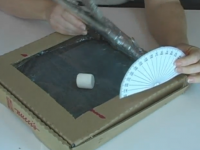This is a Guest Blog Post Written by Aurora Lipper, Owner of Supercharged Science
Can you use the power of the sun without using fancy and expensive solar cells?
You bet! We’re going to focus the incoming light down into a heat-absorbing box that will actually cook your food for you.
What is Solar Energy?
Life on Earth wouldn’t be possible without the energy from the sun. The sun’s energy travels through the vacuum of space to reach the Earth’s surface, and most of that light is visible light and infrared, with a small part being ultraviolet.
When you stand in sunlight, your arms can feel the warmth of the light, even with your eyes closed. That’s the infrared part of sunlight. The ultraviolet portion has more energy than the infrared and is also responsible for giving you a sunburn.
We’re going to make use of all the sunlight in order to make our cookies today!
Materials
- Two large sheets of poster board (black is best)
- Aluminum foil

- Plastic wrap
- Black construction paper
- Cardboard box
- Pizza box (clean!)
- Tape & scissors
- Reusable plastic baggies
- Cookie dough (your favorite)
Instructions
1. Measure an inch from each of three sides of the pizza box. Use the scissors/razor to cut a door out of the pizza box. Bend the door open if necessary. Cover the inside of the door with aluminum foil.
2. The heat needs to get trapped inside the box. Take your plastic wrap and tape it over the opening between the door and the inside of the pizza box. It doesn’t matter which side you tape it on.
3. To help the heat stay inside the box, line the inside with aluminum foil. You can also add an insulation layer with some cotton balls, shredded paper, or fine shavings. On top, place your foil. On top of this, put down the black construction paper. Use tape to secure it all in place.
4. Check to make sure the box still closes. Take your cookie dough and place it in balls onto the surface of the paper.
5. Measure the temperature inside the cookie with a thermometer. Do not eat the cookies until they register 165 on an instant-read thermometer. (There’s a real food safety concern here, as the cookie dough stays in the “danger thermal zone” for more than four hours. If you’re concerned, either omit the eggs in the recipe or use pasteurized eggs.)
6. Enjoy your cookies! Be sure to share!
Explanation
The solar cookie oven uses the light from the sun, specifically the UV and IR parts of the spectrum, to bake the dough into some delicious treats. The UV rays are energetic and are responsible for damaging our skin if we don’t shield it. The atmosphere of our earth does a lot to dissipate this energy so we aren’t subject to some of the more harmful parts of the energy that the sun emits. In fact, the sun can eject enormous, energetic bursts of radiation far into space in the form of solar flares. We experience these flares as scrambles in our satellite signals, as well as see their effects visually in the atmosphere as aurorae.
The solar cookie oven operates on the basic principle that the light can be concentrated to be directly useful for our energy needs. Instead of converting the energy into electricity to power an oven, for example, the sun’s rays are now directly heating the surfaces that the cookies rest on. A few ingredients are necessary for this oven to operate properly, which is what this experiment explores. Sunlight at the Earth’s surface is mostly in the visible and near-infrared (IR) part of the spectrum, with a small part in the near-ultraviolet (UV). The UV light has more energy than the IR, although it’s the IR that you feel as heat.
Your solar cooker does a few different things. First, it concentrates the sunlight into a smaller space using aluminum foil. This makes the energy from the sun more potent. You’re also converting light into heat by using the black construction paper. If you’ve ever gotten into car with dark seats, you know that those seats can get HOT on summer days! The black color absorbs most of the sunlight and transforms it into heat (which boosts the efficiency of your solar oven). By strapping on a plastic sheet over the top of the pizza-box cooker, you’re preventing the heat from escaping and cooling the oven off. Keeping the cover clear allows sunlight to enter and the heat to stay in. (Remember the black stuff converted your light into heat?) If you live in an area that’s cold or windy, you’ll find this part essential to cooking with your oven!
Enjoy your Earth Day Solar Cookies!
While you’re baking, enjoy some Earth Day pancakes too!
Latest Posts

Guest Post by Gabriel Morse For several years, I sat for long hours every day behind one of those battleship gray desks in a windowless, dull, gray office. The pay was enough to take care…
Read more >
This post is sponsored by Little Monsters Universe. I'm Tina Salmanowitz, an advocate for homeschooling and science education. With over a decade of experience as a science educator (in class…
Read more >
This post is sponsored by Time4Learning. Before the pandemic, it was business as usual for Boca Raton resident Nikki Warris. Her two daughters, 5-year-old Natalie and 8-year-old Lexi were…
Read more >


